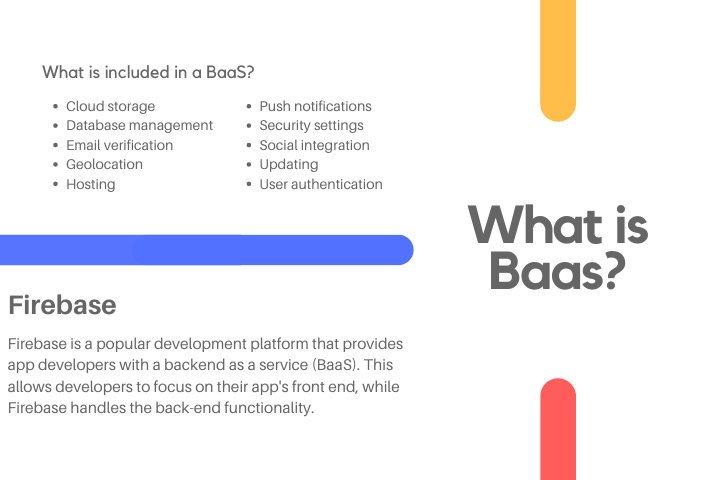What is BaaS?
BaaS, or Backend as a Service, refers to the process of using a cloud-based platform to develop and manage web or mobile applications. BaaS platforms provide developers with a way to quickly build and deploy an app without having to set up and maintain their own infrastructure. In addition, BaaS platforms often include features such as user management, push notifications and analytics that would otherwise be difficult or expensive to implement.

What is Included in BaaS?
We all know the deal – you come up with a killer app idea, find a great team to help build it out, go live… and then watch as your user base dwindles because you don’t have the time/energy/money to keep things going.
But what if there was another way? A way to build an app without worrying about all the non-app stuff? With Backend-as-a-Service (BaaS), you can do just that! You focus on building the user interface and client-side logic while your BaaS provider takes care of features like cloud storage, database management, email verification, geolocation, hosting, push notifications, security settings, social integration, updating, and user authentication.
- Cloud storage: Save data on a remote server rather than on the device itself. This can be used for storing user data, app settings, images, and other types of data.
- Database management: Manage and query a database in the cloud. This can be used for storing user data, app settings, and other types of data.
- Email verification: Verify a user’s email address before they can access certain features of the app. This can be used to ensure that only legitimate users have access to the app.
- Geolocation: Track a user’s location and use it in the app. This can be used for providing directions, finding nearby businesses, and other location-based services.
- Hosting: Host an app on a remote server. This can be used for deploying an app without having to set up and maintain your own infrastructure.
- Push notifications: Send push notifications to users when they are using the app. This can be used for sending updates, alerts, and other notifications to users.
- Security settings: Set security settings for an app. This can be used for setting password requirements, two-factor authentication, and other security measures.
- Social integration: Integrate with social networks such as Facebook and Twitter. This can be used for allowing users to log in with their social media accounts, share content from the app on social media, and more.
- Updating: Update an app in the cloud. This can be used for fixing bugs, adding new features, and generally keeping the app up-to-date without having to go through the process of submitting a new version to app stores.
- User authentication: Authenticate a user’s identity before they can access certain features of the app. This can be used to ensure that only authorized users have access to the app.
The Key Benefits of BaaS
There are many reasons why developers might choose to use a BaaS platform when developing a new mobile app. The key benefits of BaaS can be summarized as follows:
- Reduced Development Time: One of the biggest advantages of using a BaaS platform is that it can help reduce the amount of time required to develop a new app. This is because developers do not need to spend time setting up and maintaining their own infrastructure; all of that is taken care of by the BaaS provider. In addition, many BaaS platforms offer ready-made modules that can be used to add common features to an app with just a few lines of code.
- Increased Efficiency: Another big benefit of using a BaaS platform is that it can help make the development process more efficient. This is because developers can make use of the various tools and features offered by the platform to streamline their workflows. For example, most BaaS platforms include some form of a user management system that can be used to keep track of app users and their permissions.
- Reduced Costs: perhaps the most appealing benefit of using a BaaS platform is that it can help save money on development costs. This is because developers do not need to invest in their own hardware and software infrastructure; all of that is provided by the BaaS provider at a fraction of the cost. In addition, many Baa S providers offer free plans for small apps or apps with low traffic levels; this can further reduce development costs.
- Improved Scalability: one final benefit worth mentioning is improved scalability. This means that it’s easier to scale up an app when using a BaaS platform since all of the necessary infrastructures is already in place; all you need to do is add more users or increase your traffic levels accordingly. This can save you a lot of time and money compared to trying to scale up an app that’s not using a BaaS platform.
BaaS vs. mBaaS
BaaS is sometimes confused with mBaaS or Mobile Backend as a Service. Both refer to the use of cloud-based services to build and manage mobile apps, but there is an important distinction between the two. MBaaS platforms are typically geared towards specific mobile operating systems, such as iOS or Android, whereas BaaS platforms can be used to develop apps for any operating system.
In addition, mBaaS providers often offer pre-built modules that can be used to add common features to mobile apps, such as push notifications or user authentication. These modules can save developers a considerable amount of time and effort, but they may also limit the flexibility of the resulting app. BaaS platforms typically do not offer pre-built modules, instead giving developers full control over the implementation of all features.